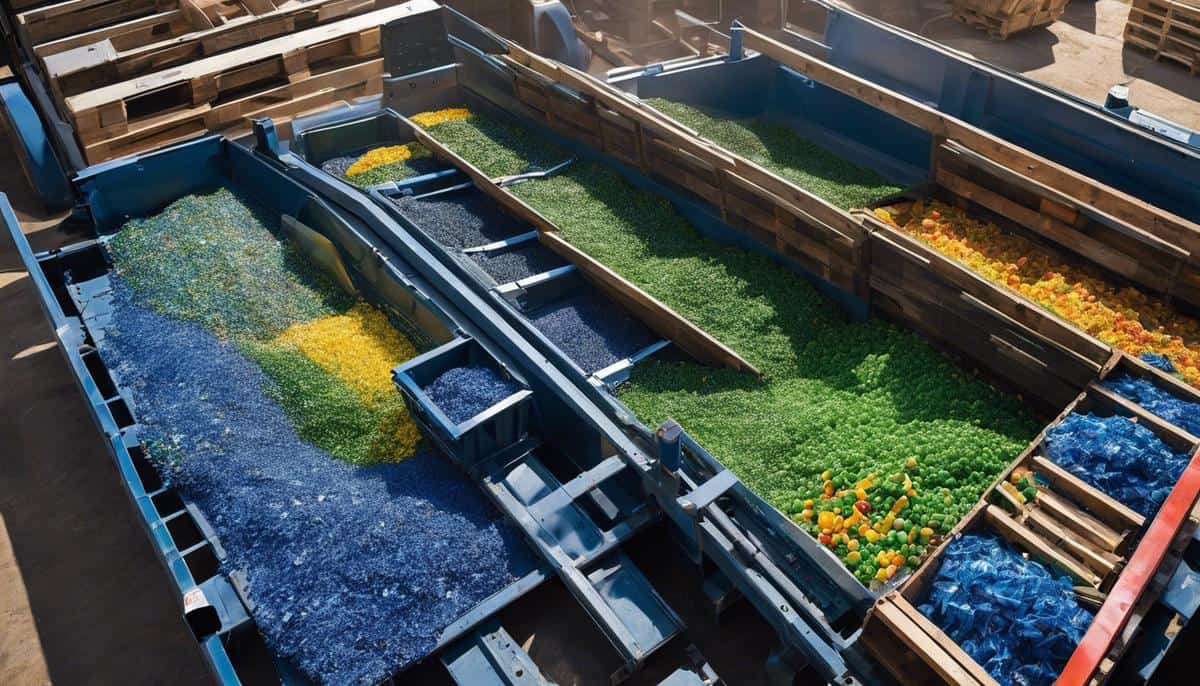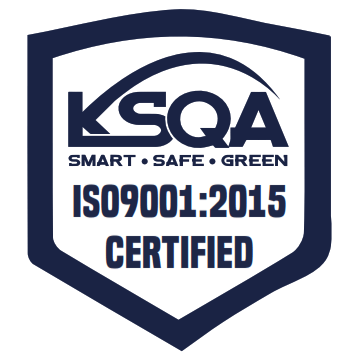As the world grapples with the burgeoning issue of plastic waste, the realm of palletized plastic recycling emerges as a beacon of innovation and environmental stewardship. This essay delves into the scientific intricacies, environmental ramifications, and technological advancements that are shaping the future of plastic recycling. It navigates through the regulatory landscapes that influence sustainable practices while dissecting the economic underpinnings that make recycling not just a moral imperative, but a financially viable enterprise. As we embark on this exploratory journey, we aim to demystify the processes that allow us to give new life to what was once considered waste, transforming it into a resource that benefits both the economy and the planet.
The Science of Plastic Recycling
The Palletized Paradigm in Plastic Recycling: A Scientific Overview
The contemporary ecological imperative necessitates a rigorous approach to what was once considered refuse—contemporary plastic recycling on a palletized scale exemplifies this ethos. This intricate process, undergirded by robust scientific systems and pronounced automation, offers both an environmentally and economically viable method for managing polymeric waste. This discourse seeks to explicate the scientific methodologies underpinning this transformative process.
Initially, the venture commences with the accumulation of plastic materials, which are often commingled and heavily contaminated. Pertinent to the endeavor is the categorical separation predicated on resin identification codes—polymers such as polyethylene terephthalate (PET), high-density polyethylene (HDPE), and polypropylene (PP) are targeted given their recyclability. Advanced sorting technologies leveraging infrared spectroscopy and X-ray fluorescence serve to segregate plastics based on chemical composition, ensuring a homogenous batch as a substrate for subsequent treatment.
Post-sorting, the materials endure a process of size reduction. Granulation and shredding mechanisms transform unwieldy articles into manageable flakes or pellets, suitable for systematic cleansing. Washing operations eradicate contaminants; a combination of surfactants, heat, and agitation facilitates the detachment of adhesives, food residues, and other impurities, crucial for ensuring the integrity of the regenerated plastic.
Drying constitutes the next phase, pivotal to eliminate residual moisture. The elevated thermal exposure is judiciously monitored to preclude physical property degradation. Here, centrifugal dryers or thermal methods are frequently deployed, furnishing a desiccated feedstock apt for extrusion.
The heart of the recycling process, extrusion melds scientific precision with industrial might. This stage witnesses the melting and homogenization of the plastic under controlled conditions of temperature and pressure within the barrels of extruders. Melt filtration is indispensable, purging the molten mass of minute contaminants. The extrusion die then imparts form, whereupon cooling and solidification eventuate uniformly pelletized recycled plastic.
These pellets, now vestiges of a once-linear economic trajectory, are primed for the reincarnation into new goods. Repeated incorporation into manufacturing conduits corroborates the scientific acumen and eco-centric philosophy propelling palletized plastic recycling. These operations abide by an imperative to not only recapture material but also conserve energy, reduce petroleum dependence, and decelerate the accretion of waste.
Through understanding and manipulating the physical and chemical properties intrinsic to plastics, humankind wields the power to perpetuate material utility while honoring environmental stewardship. The science of palletized plastic recycling is an evolving canvas of innovation, distinctly apt for the contemporary age—a testament to the confluence of scientific inquiry and ecological conscience.

Environmental Impact of Plastic Recycling
The Environmental Implications of Palletized Plastic Recycling
The conversation surrounding palletized plastic recycling frequently centers on the processual advancements and the conservation of resources. However, the interrogation of this recycling methodology extends deeper, touching on a variety of environmental implications that warrant rigorous investigation.
Central to this discourse is the life cycle assessment (LCA) of recycled plastics. Post-consumer plastics, having been diverted from landfill destinations and successfully reincarnated as pellets, emerge as actors in a complex chain of environmental impacts. The energy input-to-output ratio, while favorable in comparison to virgin plastic production, is still significant and is primarily sourced from non-renewable energy.
Distillation of the carbon footprint of palletized plastic recycling reveals greenhouse gas (GHG) emissions at different stages. These emissions are not trivial, considering the scale of operations. Energy-intensive stages such as extrusion and particularly melt filtration contribute to these emissions. A reduction in the dependence on fossil fuels for energy demands in these operations is crucial in diminishing the overall carbon footprint.
Moreover, transportation logistics pose a non-negligible environmental burden. The movement of materials to recycling centers, and subsequently to manufacturing hubs, adds to the energy expenditure and associated emissions. A decentralized recycling system might reduce these effects, fostering a more localized circular economy.
Additionally, the very philosophy of recycling may sometimes inadvertently lead to the justification of continued plastic use. The reliance on the recyclability of plastics may undermine efforts to reduce single-use plastics. The conceptual paradigm might shift towards considering the design for the environment principles from the inception of plastic products to ensure their end-of-life cycle is inherently more sustainable.
Another seldom-discussed concern relates to the inevitable downcycling of plastics. With each recycling iteration, polymer chains tend to shorten, degrading the material properties. This phenomenon limits the number of times plastics can be recycled before they become unsuitable for use, eventually needing to be relegated to waste streams. This is a key determinant in the overall sustainability of recycling operations.
Beyond the mechanical and chemical properties of recycled plastics lies a less visible concern: the potential for contamination. While rigorous washing operations are designed to remove most contaminants, some may persist, leading to the accumulation of pollutants in the material life cycle. Research into innovative purification methods and the development of contamination-resistant materials are promising but require further exploration.
The biodiversity impact, particularly in aquatic ecosystems, cannot be overstated. Microplastics generated during various stages of the recycling process can permeate ecosystems, posing risks to a wide array of organisms. Mitigation strategies, such as improved containment measures and advancements in filtration technology, must be prioritized to protect natural habitats.
In conclusion, while palletized plastic recycling stands as a testament to human ingenuity in resource conservation, it carries with it a panoply of environmental impacts that necessitate diligent attention. This holistic examination underscores the interconnectedness of recycling operations with broader ecological and societal systems. The imperatives moving forward are clear: optimize energy efficiency, enhance material purity, minimize emissions, and above all, foster an informed discourse on sustainable practices at the intersection of human activity and environmental stewardship.

Technological Advancements in Recycling
Advancements in Enzymatic Biodegradation and Polymer Innovation for Enhanced Plastic Recycling
Palletized plastic recycling represents a critical frontier in the maintenance of environmental sustainability and the advancement of circular economic models. Recent technological innovations are poised to transform this domain, underpinned by a relentless pursuit of efficiency gains and environmental benefit maximization. Among these transformative technologies, two stand out for their potential: enzymatic biodegradation and polymer innovation.
Enzymatic biodegradation leverages the specificity and efficiency of biological catalysts to address one of the most challenging aspects of plastic recycling—the depolymerization of long-chain polymers. Scientists have isolated particular enzymes, such as PETase and MHETase, which exhibit a remarkable capability to decompose polyethylene terephthalate (PET), a common component in various packaging materials. These enzymes have been the subject of intense biochemical optimization, which has led to engineered variants demonstrating heightened activity and stability under industrial conditions. Introducing such biocatalysts into the recycling pipeline can potentially degrade polymers into their constituent monomers, whereby they can be repolymerized into high-quality, virgin-grade plastic. This approach not only augments material recovery but also closes the recycling loop more tightly by providing feedstock for subsequent rounds of plastics manufacturing.
Parallel to enzymatic strategies is the focus on polymer innovation. The thoughtful design of novel polymeric materials that inherently facilitate recycling processes is reshaping the landscape of plastic production and reclamation. Breakthroughs in this sphere include the development of polymers with reversible bond structures that allow for efficient mechanical recycling. Moreover, there is ongoing research aimed at creating polymers that can self-heal or indicate wear and degradation through visible changes—properties that can signal the need for replacement or recycling. The overarching objective of such innovations is to integrate end-of-life considerations into the nascent stage of material design, thereby preemptively addressing recycling challenges.
The aforementioned technological advancements are not merely standalone solutions but are, in fact, complemented by digital technologies that drive the recycling process. Specifically, the integration of artificial intelligence (AI) with robotics for dynamic sorting systems is indicative of the digital transformation of recycling facilities. Machine learning algorithms trained on vast datasets can distinguish between subtle variants of plastics, leading to more precise separation of materials destined for different recycling pathways. Such refinement in sorting aligns perfectly with enzymatic degradation and novel polymer constitutions, forming a complementary trio that collectively enhances the output quality of recycled plastics.
Moreover, blockchain technology has been identified as a tool to empower the traceability and transparency in the recycling supply chain. By recording detailed lifecycle data, blockchain empowers responsible sourcing and incentivizes the use of recycled content by providing verifiable information on the origin, composition, and history of materials.
In conclusion, the symbiosis between biotechnological methods, polymer chemistry, and digital innovations is engendering a more efficient and ecologically sound process for recycling plastics. The era of advanced technologies in palletized plastic recycling heralds an optimistic pathway towards sustainability, whereby the valorization of waste materials could become the norm, and the concept of ‘waste’ itself is gradually side-lined in favour of resource recovery and reuse. Such technological strides underscore the industry’s commitment to overcoming existing challenges and envisioning a future where material recyclability is an intrinsic property, not an afterthought.
With an understanding of the fundamental technical processes and scientific advancements in the realm of palletized plastic recycling, as previously delineated, one must now pivot to the complex world of regulatory frameworks and policy instruments that govern these meticulous operations.
The regulatory landscape for this sector is intimately intertwined with local, national, and international directives that seek not only to ensure the environmentally sound management of recycled materials but also to foster a market for post-consumer products. At the national level, the United States Environmental Protection Agency (EPA) provides guidelines under the Resource Conservation and Recovery Act (RCRA), which classifies solid and hazardous waste management, highlighting the necessity of appropriate recycling practices to prevent environmental contamination.
Concurrently, policies such as the National Sword Policy, implemented by China in 2018, have drastically altered export markets for recyclable plastics by setting strict contamination limits, thus affecting the trade dynamics and necessitating higher purity levels in recycled plastics. Such international measures have effectively shifted the onus onto domestic recycling industries to innovate and refine their processes.
In terms of specific regulation, the thrust for the plastic recycling industry is on adhering to the strict contaminant thresholds in recycled pellets, which are stipulated by the U.S. Food and Drug Administration (FDA) for plastics intended for food contact applications. This underscores the importance of employing melt filtration, as previously stated, along with other purification strategies.
Furthermore, state-level mandates such as California’s Rigid Plastic Packaging Container (RPPC) Law, incentivize the use of recycled content in the manufacturing of new plastic containers by setting minimum post-consumer material content requirements. Policies as such are erected to incite a circular economy, driving efforts to insert recycled pellets back into productive use, thereby decreasing reliance on virgin materials.
The evolution of Extended Producer Responsibility (EPR) laws presents another growing influence on the industry. These regulations operationalize the polluter pays principle, making producers financially or physically responsible for the treatment or disposal of post-consumer products. EPR schemes are gaining traction as a means of holding producers accountable, fostering eco-design and bolstering demand for recycled materials.
Also of paramount importance to regulatory discourse is the role of voluntary industry standards such as those proffered by ASTM International. These standards provide technical guidelines for the quality, testing, and grading of recycled plastics, which aid in harmonizing practices and facilitating trade in the recycled polymers market.
From a policy perspective, subsidies, tax incentives, and grants are tools often utilized by governments to encourage investment in recycling infrastructure. Fiscal incentives like the New Markets Tax Credit (NMTC) in the U.S. can be pivotal for nurturing nascent recycling enterprises. Moreover, a surge in governmental and non-governmental initiatives that aim to educate and enhance recycling participation rates amongst the public directly influences the supply chain, amplifying the input material quality and quantity.
Last but not least, amidst the changing regulatory and policy backdrop, the plastic recycling industry must remain alert to the burgeoning swell of concern regarding microplastics and their dissemination across ecosystems. Policies have begun to pivot towards addressing leakage into aquatic environments, exemplifying how the incorporation of filtration technologies and clean-up efforts are becoming not only best practice but regulatory requirements.
In summation, the palletized plastic recycling industry is deeply embedded within a web of regulatory and policy measures. These measures guide the industry’s conduct and substantially influence technological, economic, and environmental outcomes—a terrain where adherence to polices ensures sustainability, innovation, and an advancing frontier in resource recovery.

The Economics of Palletized Plastic Recycling
The Economics of Palletized Plastic Recycling: An Insight into Market Dynamics
Unlocking the economics of palletized plastic recycling requires an acute awareness of both its potential profitability and the systemic challenges it faces. To gauge economic feasibility, one must consider multiple variables, from operational costs to market demand for recycled materials. The aim here is not to exhaustively analyze each individual component, but to elucidate the overarching economic conditions that shape the market dynamics of this industry.
When investigating the economic landscape of palletized plastic recycling, one pivotal element is the price volatility of virgin and recycled plastics. This volatility is driven by fluctuating crude oil prices, as virgin plastics are predominantly petroleum-based. Conversely, recycled plastics offer a more stable pricing model, as they are less subject to these external pressures. Despite this, the upfront investment for establishing sophisticated recycling infrastructure can be substantial, yet is essential for maintaining quality standards that support market acceptance.
Market demand for recycled plastics is another critical factor influencing economic feasibility. Industries that integrate recycled plastics into their production chains create a market pull for these materials. For example, automotive and packaging industries have set ambitious targets for the inclusion of recycled content in their products, adhering not only to sustainability goals but also to consumer demand for greener alternatives. This market pull helps to stabilize the economic model for recycling operations by ensuring a consistent demand for recycled pellets.
Furthermore, assessing the influence of regulatory frameworks uncovers a complex interplay between incentivization and compliance. On one hand, regulations such as those under the Resource Conservation and Recovery Act (RCRA) mandate responsible waste management practices, promoting recycling. On the other hand, stringent contaminant thresholds, as set by the FDA for recycled materials in food-contact applications, can elevate processing costs to ensure compliance. Moreover, state-level mandates, like California’s Rigid Plastic Packaging Container (RPPC) Law, not only enforce recycling directives but also can lead to the creation of markets specifically for recycled plastics, cementing their economic relevance.
The onset of Extended Producer Responsibility (EPR) laws also significantly affects the market dynamics, creating economic incentives for manufacturers to partake in the end-of-life management of plastic products. While EPR can entail additional costs for producers, it places recycling within the economic circuit of production and consumption, fostering closed-loop systems that can reduce overall environmental impact while potentially offering cost savings in raw material procurement.
Subsidies and tax incentives are further instruments that influence the economic calculations of businesses entering the recycling market. These financial mechanisms can alleviate the initial capital expenditure for recycling facilities, making the investment more attractive and offering a quicker route to profitability. Concurrently, government and non-governmental initiatives aimed at boosting recycling participation rates can play a conducive role in ensuring steady supply streams of recyclable plastics, which is cardinal for the operational efficiency and economic viability of recycling plants.
However, apprehensions about microplastic pollution have spurred a renewed focus on policies targeting their sources and impacts. The burgeoning awareness of microplastics’ environmental ramifications could spur new regulatory actions, potentially reshaping the economic environment for plastic recyclers by requiring additional control measures or the development of innovative technologies to minimize such contamination.
In conclusion, the economic feasibility of palletized plastic recycling hinges on a composite of factors encompassing market demand, regulatory landscapes, and the interaction between supply chain costs and the price stability of recycled materials. The prospect for palletized plastic recycling to be not only environmentally but also economically sustainable is promising, provided that these factors harmoniously confluence to support the recycling industry’s continued growth and integration within broader material recovery paradigms.
We stand at a pivotal juncture in our pursuit of environmental sustainability, where the concerted efforts of science, technology, and policy coalesce in the quest to mitigate plastic pollution. The insights garnered from the examination of palletized plastic recycling illuminate a pathway to a more sustainable future, revealing how each stakeholder, from the consumer to the manufacturer and policymaker, plays a critical role in this intricate dance of material rebirth. As the curtain draws on this exploration, it becomes clear that the collective adoption and refinement of such recycling initiatives can steer us towards a circular economy, where the value of materials is perpetuated, resources are conserved, and the delicate balance of our ecosystems is maintained for generations to come.








